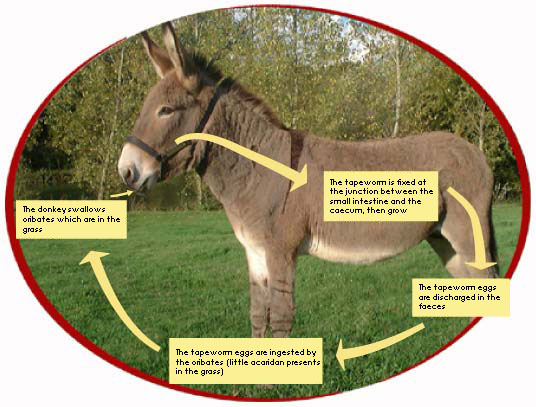|
The tapeworm is a flat and segmented worm with
variable sizes according to species:
- 4 to 8 cm length and 1 cm broad for Anoplocephala perfoliata
- 20 to 80 cm of length and 2 cm broad for Anoplocephala magna
- 1 to 5 cm length for 0.5 cm broad for Paranoplocephala mamillana.
It is fixed at the junction between the small intestine
and the caecum with a strong sucker..
| Contamination and cycle of
life |
 |
The adult tenias emit segments containing thousands of eggs which
are found in the large intestine, and are discharged in faeces.
These eggs are ingested by the oribates which are microscopic acaridan
which feed on vegetable scraps and thus play a part in ground fertilization.
Infection is caused by the eating of forage mites (the worms intermediate
stage of development). They become adults in 4 to 6 weeks and will
lay eggs.

Cycle life of Tenia
So, the concentration of the tapeworm in the pastures will increase
during the season and will be the maximum in October-November. The
first clinical signs will appear during the winter.
| Symptoms |
 |
The symptoms of the infestation can be different according to the
concentration of the tapeworm in the donkey's body:
- less than 25: discrete digestive disorders (alternation diarrhoeas,
constipations...)
- 25 to 200: arrest of the intestinal transit, bacterial fermentations
and severed colics.
- more than 200: possibility of necroses intestinal mucous membrane
loading to rupture of the intestinal wall and peritonitis.
| Prevention - Treatment |
 |
It is advised to worm the donkeys in october/november. It is better
to worm the donkey also in June in the event of donkey infestation.
It is advised to keep the treated animals in the stable for a few
days in order to not infeste the pastures. In this way the eggs
laid after the treatment will not contaminate the pasture.
|










